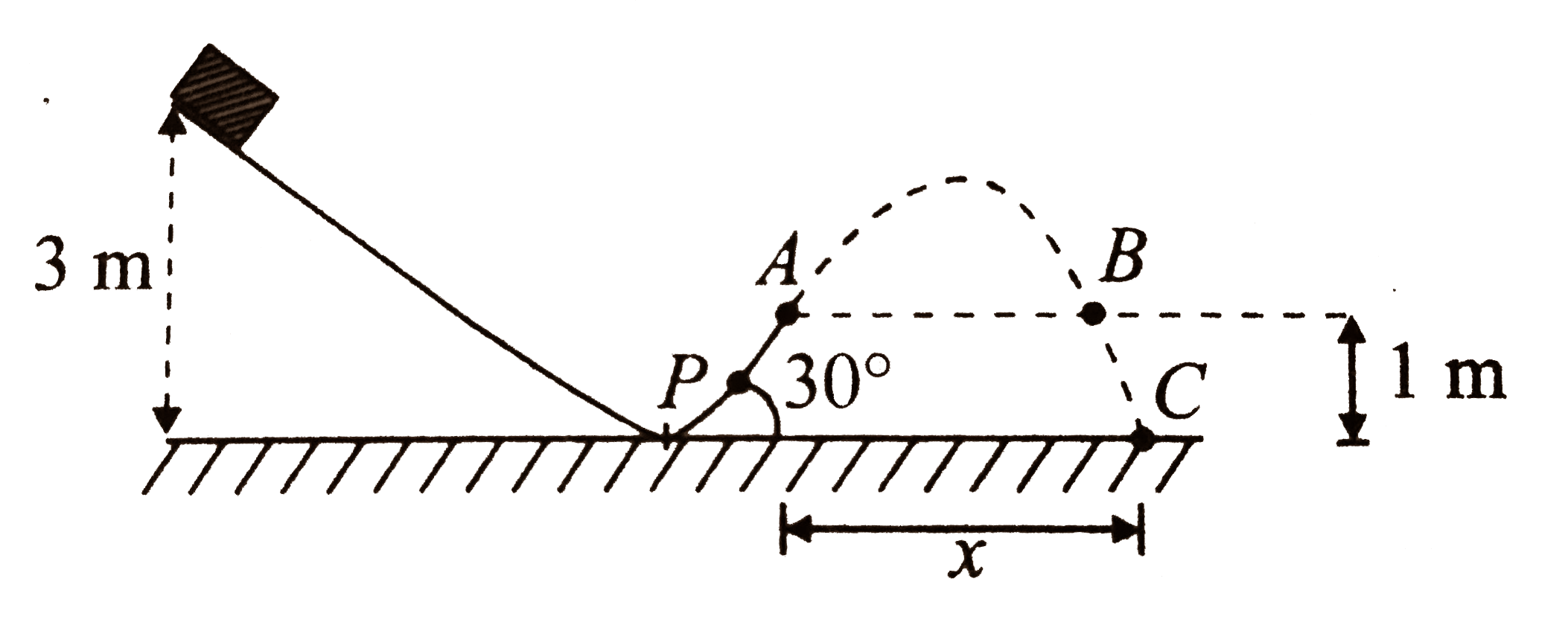A 0.098−kg block slides down a frictionless track as shown in (Fig. 5.208).
 .
.
The horizontal distance x travelled by the block in moving from A to C is.
(1+√3)m
(1−√3)m
(√3+3))m
g meter
The correct Answer is:C
(c) 12mv2=mg(3−1)=2mg [from conservation of energy]
or v=√4g=2√g
Vertical component at A is 2√gsin30∘=√g
Time of flight,
T=2vsinθg=2√gg=2√g
Using S=ut+12at2, we get
−1=√gt−12gt2or12gt2−√gt−1=0
t=√g±√g+4×12g2×g2t=1±√3√g
Neglecting negative time, t=1±√3√g
x=2√gcos30∘[1±√3√g]orx=(√3+3)m.
Topper's Solved these Questions
- KINEMATICS-2BOOK - CENGAGE PHYSICS ENGLISHCHAPTER - KINEMATICS-2EXERCISE - Exercise Integer
9 Videos
- KINEMATICS-2BOOK - CENGAGE PHYSICS ENGLISHCHAPTER - KINEMATICS-2EXERCISE - Exercise Assertion - Reasoning
5 Videos
- KINEMATICS-1BOOK - CENGAGE PHYSICS ENGLISHCHAPTER - KINEMATICS-1EXERCISE - Integer
9 Videos
- KINETIC THEORY OF GASESBOOK - CENGAGE PHYSICS ENGLISHCHAPTER - KINETIC THEORY OF GASESEXERCISE - Compression
2 Videos
Similar Questions
A 0.098−kg block slides down a frictionless track as shown in (Fig. 5.208).
 .
.
The time taken by the block to move from A to C is.
View SolutionA 0.098−kg block slides down a frictionless track as shown in (Fig. 5.208).
 .
.
The time taken by the block to move from A to B is.
View SolutionA block slides down a frictionless, inclined plane that makes a 30∘ angle with the horizontal. Find the acceleration of this block.
View SolutionA block is released from A on a frictionless track as shown in Fig. 7.2.6. What is the magnitude of radial acceleration and the total acceleration of the block at B ?
View SolutionA block slides down a curved frictionless track and then up an inclined plane as in figure. The coefficient of kinetic friction between the block and incline is μk. Find the maximum height reached by the block.

View SolutionAll surfaces shown in figure are smooth. Find velocity of wedge (of mass M) when the block (of mass m) reaches the bottom of the wedge.

View SolutionTwo blocks A and B are connected to each other by a string and a spring , the string passes over a frictionless pulley as shown in the figure. Block B slides over the horizontal top surface of a stationary block C and the block A slides along the vertical side of C, both with the same uniform speed. The coefficient of friction between the surface and blocks is 0.5,K=2000N/m. If mass of A is 2kg calculate mass of B.
 .
.
View SolutionA block of mass m is gently placed over a massive plank moving horizontal over a smooth surface with velocity 10ms−1. The coefficient of friction between the block and the plank is 0.2. The distance travelled by the block till it slides on the plank is [g=10ms−2]
View SolutionA 5 kg block is placed on the top of a 15 kg block as shown in figure . A horizontal force of 60 N is applied to the 15 kg block and the 5kg block is tied to the wall . The coefficient of friction between moving surfaces is 0.2

(a) Draw the free body diagram for each block w.r.t ground and identify the action reaction forces between two blocks .
(b) Determine the tension in the string and magnitude of the acceleration of the 15 kg block .
View SolutionTwo blocks A and B are connected to each other by a string and a spring, the string passes over a frictionless pulley as shown in the figure. Block B slides over the horizontal top surface of a stationary block C and the block A slides along the vertical side of C, both with the same uniform speed. The coefficient of friction between the surfaces of blocks is 0.2. Force constant of the spring is 1960 newtons/m. If mass of block A is 2 kg. The mass of block B and the energy stored in the spring are _____ kg and _____ J.

View Solution
